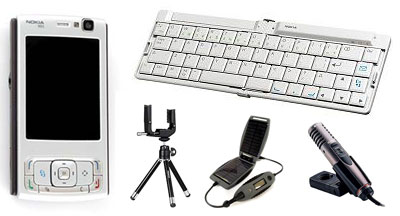For the last year there has been quite a bit of talk about mobile phone reporting in Africa. For good reason too, since this lowers the technology barrier to getting stories out of hard-to-reach places. Imagine, all you need to do is find a journalist and equip them with an adequate mobile phone Now you can record interviews in video and audio, take pictures and upload in almost any part of the continent.

Netherland’s based AfricaNews has been a pioneer in this space, starting last year with their “Voices of Africa” section of their site. I’ve been continually impressed with how they find, train and equip their journalists all over Africa. My one problem with what they do is that they don’t allow for the proliferation of their reporters work around the web by hamstringing the ability to share by embedding the reports in other websites.
Colin Daniels is the Publisher for Times Online in South Africa, arguably one of the better newspapers and always on the cutting edge of news sites online globally. A couple weeks ago he posted on his personal blog about a new initiative in where Nokia is testing mobile journalism through local universities using the Nokia/Reuter’s mobile newskit. He says,
“This has all been made possible by constant technological breakthroughs and the portability and immediacy of connected mobile devices; it is becoming increasingly feasible for journalists to replace their pens and dictaphones for converged smart phones with exceptional audio/visual capabilities such as the Nokia N95. Add a keyboard, tripod, and an external microphone and all of a sudden you have a portable newsroom and studio in one…”
A true, and exciting statement that applies to mainstream journalism and blogging. Colin refers to the N95 “Mojo” toolkit (pictured above) that Reuters uses as well. The value here is that as mainstream news sources put more resources towards mobile journalism the tools get better for everyone (amateur and professional).
All of this optimism has to be tempered with some real-world examples of how it’s still a difficult field to work in and how the technology is still not quite there for full-fledged real-time news feeds. David Axe, a war journalist, wrote a fascinating article for Wired on the failures of his mobile phone trials in Chad matching up a Nokia N95 with streaming mobile news service Qik.
It should be noted the problem was not with the phone, but with the web service Qik and the poor mobile data network in Chad. This can be a real problem for anyone using MMS or any other GSM service. Though some parts of Africa have strong networks, many others are home to the worst in the world. Of course, this makes Africa one of the great testing grounds for any new device or service, so there is a silver lining to every cloud.
“…there should be a “store†function, whereby you can shoot a video in some austere location, save it to your phone’s memory, then stream it later once you’ve got a solid network. With that function alone, I could’ve filed scores of fascinating videos about refugee camps, peacekeepers and urban combat.”
A simple solution, utilizing SD card memory could have made his trial a success. David’s quote above serves to underscore one other incredibly important point; web and mobile services need to at least test in Africa, if not have a small development shop there to truly create robust applications. After all, if it can work in Africa, it can work anywhere.
